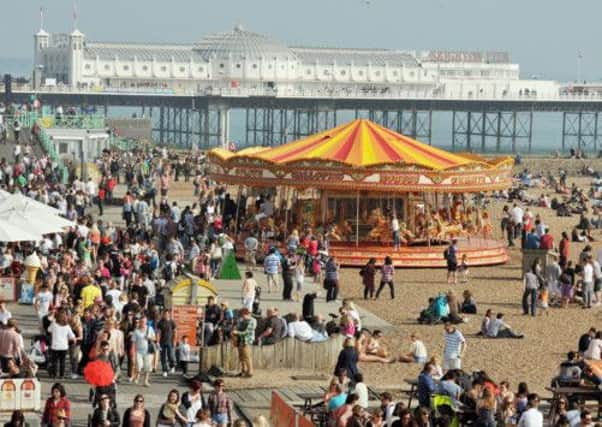Brighton rocks


Mark Sheridan had it about right.
That fine British comedian who was for some time the darling of the music halls, had a hit in the early years of last century with his song “You can do a lot of things at the seaside – that you can’t do in town”.
It was certainly true as far as Brighton was concerned, a seaside resort with an emphasis on hedonism.
Advertisement
Hide AdAdvertisement
Hide AdMuch has changed since those days and you can’t help but feel a wee bit sentimental to see the skeletal ruins of the old West Pier, sticking defiantly above the waves. Building this landmark started in 1866, and it was designed by Eugenius Birch, the undisputed maestro of UK piers. But, in 2003, and after a closure of several years, the pier’s pavilion and then the ballroom caught fire. The sea and several storms did the rest. The West Pier’s younger companion, the Palace Pier, is happily still with us, and is home to all sorts of cafes, bars, amusement arcades and spine-tingling rides. Fancy a henna tattoo or a stick of candy-floss? Do you want a reading from the tarot cards or some fish and chips? The Palace Pier (which is what everyone calls it, despite it having been renamed Brighton Pier by the owners) is also the place where Pinkie, in Graham Greene’s chilling novel Brighton Rock (and the two films made of it) makes his revelatory 78rpm recording for the unsuspecting Rose.
These days it’s where you can get yourself a nice glass of wine, and settle down to watch the world go by.
Truth is, Brighton has attractions galore – ranging from the Museum of Fishing to the Toy Museum, from art galleries to numerous festivals spread throughout the year. Two of the best are those devoted to food and drink (the local tourist board will provide details and dates) and the Brighton Festival and Fringe Festivals themselves, which are claimed to be the second biggest arts events in the UK, after Edinburgh.
Of course, Brighton’s biggest and oldest permanent attraction is the bizarre confection that is the Royal Pavilion, a glorious explosion of pepper-pots and minarets on the outside, and a mind-boggling juxtaposition of Chinese and Indian designs for the interior.
Advertisement
Hide AdAdvertisement
Hide AdIt was built by the Prince Regent, who wanted a “palace by the sea” and like much else in Brighton it has seen the ups and downs of life. Just after she came to the throne, Queen Victoria spent a few nights there, and evidently loathed it. She loathed Brighton as well, it was, she said, “a vulgar little town”. Wanting nothing to do with her uncle’s eccentric residence, she almost immediately put it on the market – it was purchased by the then Brighton Corporation, who were more than slightly surprised to discover, when they were handed the keys to the front door that Her Gracious Majesty’s agents had virtually stripped the place – even down to removing some of the exotic wallpaper. The last century and a half has been a labour of love, diligently tracking artefacts from the Regent’s time, and persuading our current royal family to hand back a few relevant sticks of furniture.
The café on the first floor of the Pavilion is an unexpected delight – light lunches and teas are served, and on a sunny day the terrace, overlooking the gardens, is hard to beat for service, value, location and atmosphere. Check out the distinctive teapots...
After sightseeing, Brighton has more than 400 restaurants; more per head than anywhere outside London. Some are there for months and fail, some have enviable reputations that date back for decades, but one thing is certain – you can find just about every world cuisine somewhere. Several are on the seafront, and there’s nothing more pleasant than winding down after a good walk with a bottle (or two) of what you fancy and a plate of nibbles, just watching the world saunter by.
If you have an eye for the antique or the collectable, then Brighton offers both. The Lanes (head for Ship Street) is pretty pricey, and you’d better have a quid or many in the bank to afford what they offer, but the main street of Kemptown has surprisingly good bargains in several eclectic shops, and a flea market arcade may turn up a few surprises that won’t empty the wallet. Brighton is brilliant, for a day, a weekend, or longer – there’s so much to explore and enjoy that is within easy distance, whether by car, bus, rail or foot. The only thing that it doesn’t have is a sandy beach. It’s not “shingle” as some folk put it, it is pebbles. Big pebbles. Very big pebbles. But the sound of the sea washing against them, the lovely noise of their shift and sliding, is wonderful. An aural version of Proust’s dunking of his madeleine biscuits – as it always brings back the happiest of memories.
Getting there
Advertisement
Hide AdAdvertisement
Hide AdTrains from Yorkshire to London run frequently. Change there for Brighton trains from St Pancras (Thameslink)which take about an hour.
The AA provides a useful guide to the best road routes (Classic Route Planner), from door to door.
Visit Brighton, with a wealth of details on what to see and do, and tips on where to stay, is on 01273 290337, or you can go to visitbrighton.com.